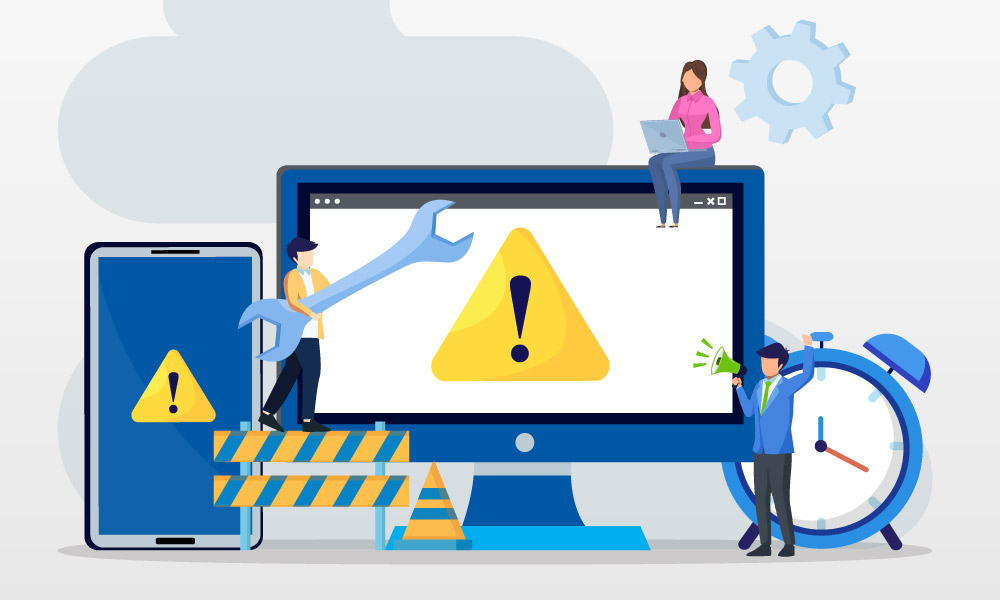How to Choose the Best WordPress Maintenance Services
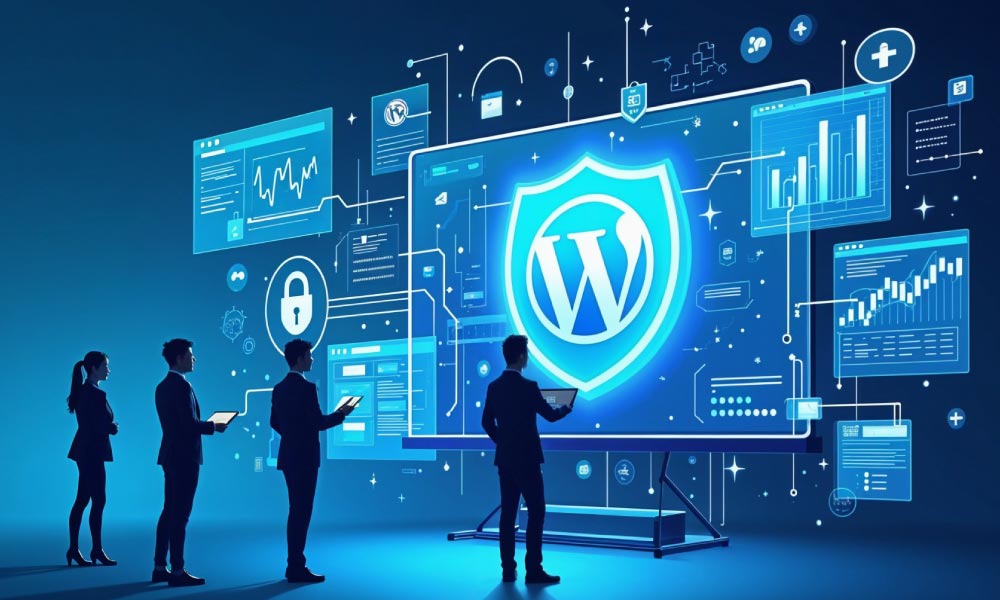
Choosing the best WordPress maintenance services isn’t just about keeping your site online—it’s about protecting your business from costly disruptions.
What if an outdated plugin crashes your homepage? Or a hacker exploits a hidden vulnerability, bringing your entire site down?
Preventative care is the key to security, speed, and long-term success. Regular updates, backups, and performance optimizations ensure your site runs smoothly while giving you peace of mind.
The right maintenance service doesn’t just fix issues—it prevents them. Keep reading to learn how to choose a provider that keeps your website secure, fast, and reliable.
Key Takeaways:
Evaluating the Best WordPress Maintenance Services
Not all WordPress maintenance services are built the same.
Some offer comprehensive solutions, while others focus on specific areas like security, backups, or performance.
To make an informed choice, you need to understand what goes into proper site maintenance.
Moreover, a WordPress website isn’t self-sustaining. It requires ongoing attention to remain secure, fast, and functional.
The best WordPress maintenance services cover four essential areas: security, performance, backups, and recovery:
Security Monitoring and Updates
WordPress is a prime target for hackers. Every day, new vulnerabilities emerge in themes, plugins, and even WordPress itself.
Without regular security updates, your site could become an easy entry point for cybercriminals.
A solid WordPress maintenance plan includes:
The right maintenance service actively monitors threats and applies updates as soon as vulnerabilities are discovered—so your site stays protected 24/7.
Performance Optimization and Speed Improvement
A slow website drives visitors away. If your pages take too long to load, users will leave, and search engines will push your site down in rankings.
Performance optimization is key to maintenance, ensuring your site remains fast and responsive. Here’s how:
- Optimized images using tools like ShortPixel or Smush to reduce file sizes without losing quality.
- Caching plugins such as WP Rocket or W3 Total Cache to optimize site data and improve load times.
- Content Delivery Networks (CDNs) like Cloudflare to serve your website from multiple locations worldwide.
- Minified CSS, JavaScript, and HTML files to reduce unnecessary code and speed up rendering.
- Plugin management to remove bloated, unused extensions that slow down your site.
A well-maintained site loads in seconds, keeping visitors engaged and search engines happy.
Backups and Recovery Systems
Website crashes, cyberattacks, or accidental data loss can happen at any time. A reliable backup system ensures you can quickly restore your site without major downtime.
A professional WordPress maintenance service will:
However, keep in mind that not all files are included in backups:
- Core WordPress files (managed by WordPress.com) are typically excluded.
- Files stored outside of the primary directories may not be saved.
- Database tables unrelated to WordPress or those lacking unique identifiers are ignored.
- Cache files and additional backup directories are omitted to avoid redundancy.
- Subdirectory WordPress installs (if multiple installations exist) may not be backed up automatically.
Differences Between In-House and Outsourced Services
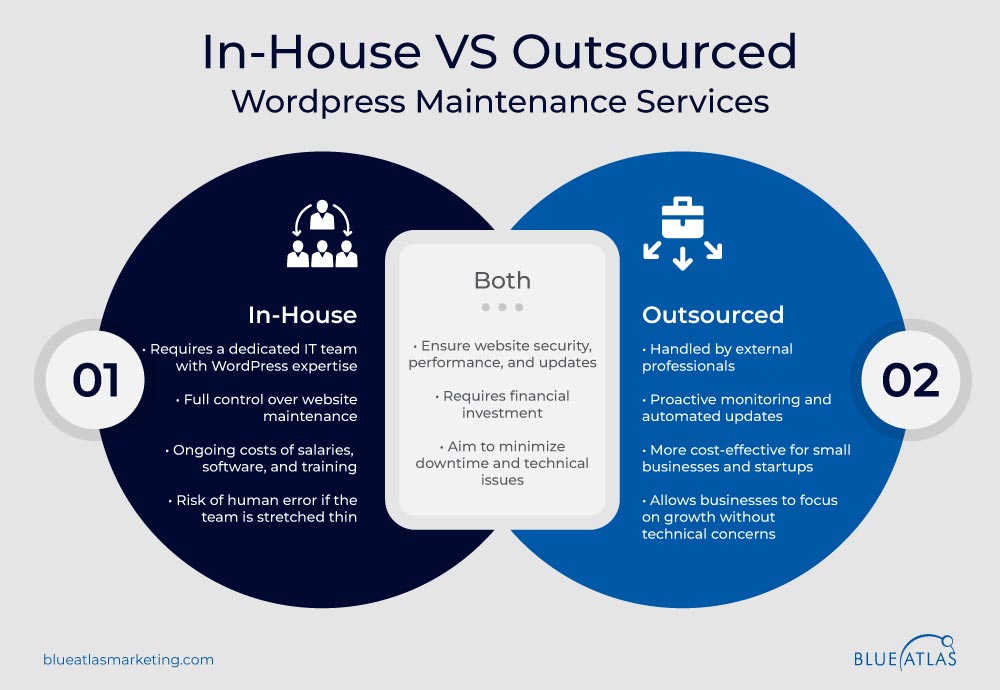
Handling maintenance in-house or outsourcing it to professionals both have pros and cons. The right choice depends on your budget, expertise, and business priorities.
When In-House WordPress Management Makes Sense
If you have a dedicated IT team with WordPress expertise, handling maintenance internally might be a viable option. This approach works when:
However, in-house management comes with hidden costs—time, effort, and the risk of human error.
If your team is already stretched thin, website maintenance may take a backseat, leading to security risks and performance issues.
Why Outsourcing WordPress Maintenance is a Smart Move
For small businesses, startups, and organizations without a dedicated IT team, outsourcing maintenance is often the smarter choice.
Professional WordPress maintenance services provide:
If website upkeep feels overwhelming, outsourcing allows you to focus on growing your business without worrying about technical headaches.
Factors to Consider When Selecting a Service Provider
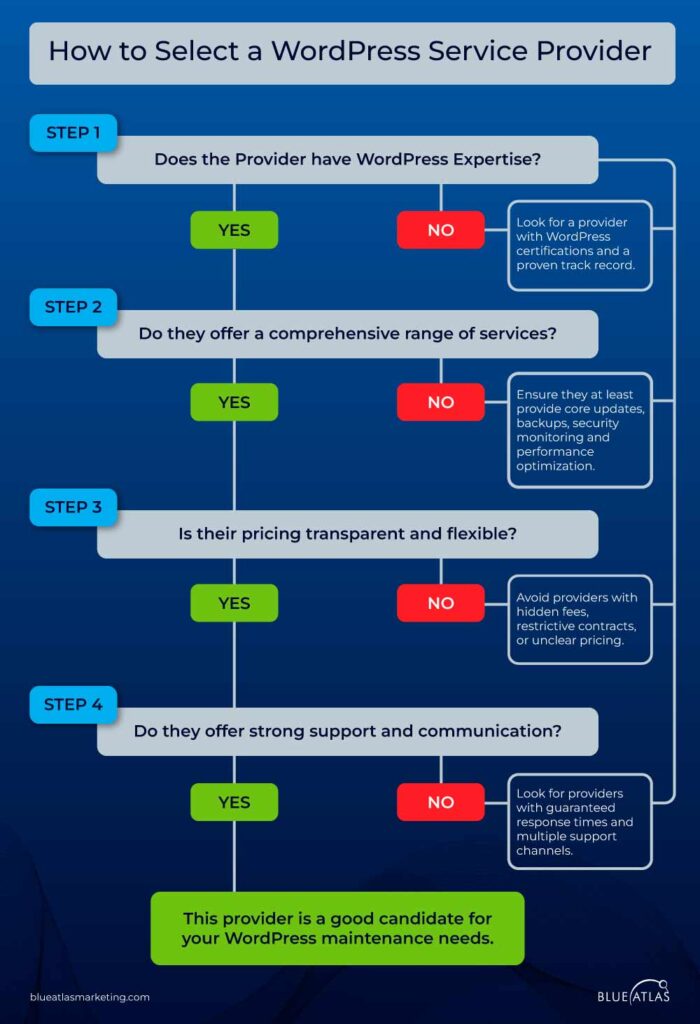
Not all WordPress maintenance services are built the same.
Some providers offer top-tier support, while others cut corners, leaving your site vulnerable.
The secret element is knowing what to look for before making a commitment.
Expertise and Experience
WordPress may be user-friendly, but maintaining it at a professional level requires technical know-how.
A service provider’s experience determines how well they handle updates, security threats, and site performance!
One way to gauge expertise is by checking for certifications and credentials.
Many top providers have teams that hold specialized WordPress certifications, demonstrating their commitment to staying current with industry standards.
If a provider invests in training and development, it’s a good sign they take maintenance seriously.
Moving forward, beyond certifications, client history speaks volumes.
A provider with a solid track record of managing WordPress sites across different industries is more likely to handle complex issues efficiently.
Look for case studies, testimonials, or portfolio examples to see if their expertise aligns with your needs.
Choosing an experienced provider ensures your website is in capable hands.
Range of Services Offered
Not all maintenance services offer the same level of care.
Some focus solely on basic updates, while others provide end-to-end solutions, including performance optimization, uptime monitoring, and even custom development.
At a minimum, your provider should handle (a) core updates for WordPress, themes, and plugins, (b) daily backups with easy restoration options, (c) security monitoring to prevent hacks and malware attacks, (d) performance optimization to keep your site fast and efficient.
Beyond the essentials, consider whether you need additional services.
Some businesses benefit from having a provider that also offers custom development, plugin modifications, or SEO enhancements.
If you plan to scale your site, working with a provider that offers more than just maintenance can be a smart, long-term decision.
Pricing and Transparency
Website maintenance shouldn’t come with financial surprises.
Pricing structures vary widely among providers, and some use vague pricing models that make it hard to know what you’re actually paying for.
Before signing up, check for transparent pricing with a clear breakdown of services included.
Next, there should be no hidden fees. Some providers charge extra for things like emergency support or additional backups.
Lastly, Flexible plans that don’t lock you into long-term contracts unless necessary.
Some providers offer monthly subscriptions, while others work on a one-time payment model.
Subscription plans are useful for ongoing care, but if you only need occasional maintenance, a pay-as-you-go option might be more cost-effective.
Avoid services that trap you in restrictive contracts with high cancellation fees.
A reputable provider should be confident in their service quality and offer flexible terms that work for your business.
Support and Communication
Some providers offer dedicated account managers, ensuring that you work with someone who understands your website inside and out.
This level of support can be especially useful for businesses that rely heavily on their online presence.
Before committing to a provider, test their responsiveness.
Send an inquiry and evaluate how long it takes for them to reply. If they take days to respond to a simple question, imagine how slow they’ll be when you have a real issue.
Reliable maintenance services offer:
Guaranteed response times, ideally within 24 to 48 hours for standard issues.
Multiple support channels, including email, live chat, and phone assistance.
Proactive communication, ensuring you’re notified of any critical updates or security risks.
Choosing a WordPress maintenance provider is about more than just pricing—it’s about ensuring your website remains secure, functional, and properly supported.
Signs It’s Time to Upgrade Your Maintenance Strategy
Your website might look fine on the surface, but hidden issues could be slowing it down, exposing security risks, or even driving visitors away.
Knowing when to upgrade your maintenance approach can save you from bigger problems down the road.
| Indicators | Reason Behind | Action Items | When to Transition to a Professional Maintenance Agency |
| Slow loading times | Unoptimized images, excessive scripts, or a slow hosting provider. | Optimize images, use a caching plugin, upgrade hosting, and enable a CDN. | If speed issues persist despite optimizations. |
| Frequent website crashes | Server issues, incompatible updates, or plugin conflicts. | Check server logs, update plugins/themes, and monitor for conflicts. | If crashes happen frequently and impact business operations. |
| Outdated plugins and themes | Lack of regular updates increases security risks and compatibility issues. | Regularly update WordPress, plugins, and themes; remove outdated ones. | If updates are not managed properly, leading to functionality issues. |
| Security warnings and vulnerabilities | Repeated failed login attempts, malware alerts, or outdated security settings. | Implement stronger login security, run malware scans, and update security patches. | If security risks increase and site vulnerability is a concern. |
| Broken links and missing content | Deleted pages, incorrect URLs, or missing media files affecting user experience. | Fix broken links, update missing pages, and ensure content is correctly linked. | If website usability is suffering due to missing or broken elements. |
| Declining search engine rankings | Poor performance, lack of SEO maintenance, or outdated content. | Improve website speed, update content regularly, and optimize for SEO. | If rankings continue to drop despite SEO efforts. |
| Limited time or expertise for maintenance | Maintenance tasks take up too much time or require technical knowledge. | Consider outsourcing maintenance to professionals for efficiency and security. | If maintenance is overwhelming or interfering with business priorities. |
Optimizing Website Performance Through Maintenance
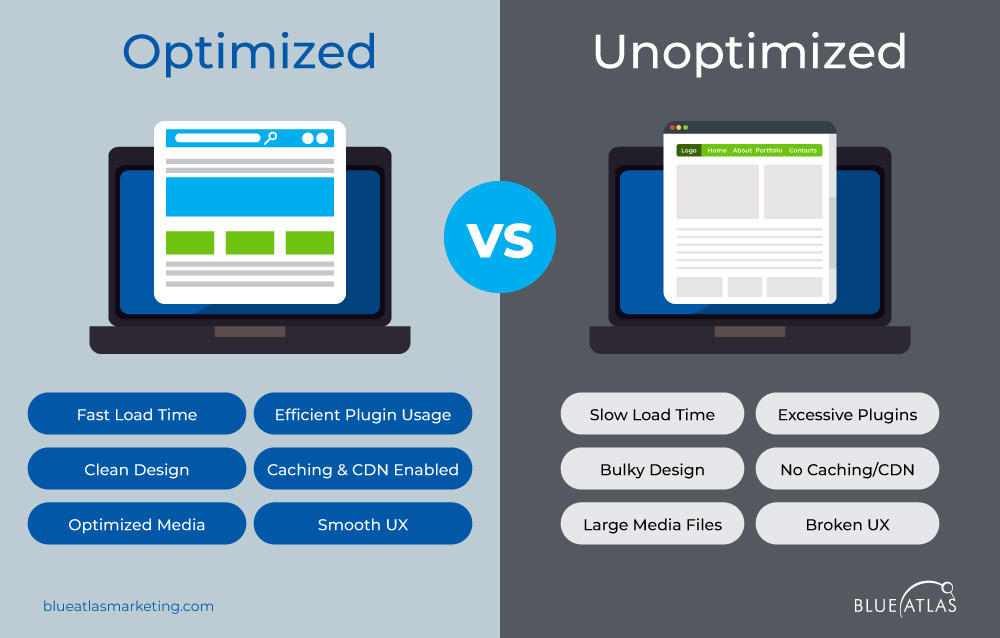
Regular maintenance ensures that your website performs at its best, loads quickly, and balances both aesthetics and functionality.
Techniques for Speed and Uptime Optimization
Website performance affects user experience, search rankings, and overall reliability.
A slow or unstable site can frustrate visitors, increase bounce rates, and lead to lost revenue. To maintain speed and uptime, focus on these key areas:
Balancing Aesthetics and Functionality
A visually appealing website is important, but not at the cost of usability.
A cluttered design with excessive animations and media can frustrate users, while a plain, overly functional site may fail to engage visitors.
The main element is finding a balance between design and performance.
User-friendly websites prioritize clarity and accessibility.
A clean layout, intuitive navigation, and clear call-to-action buttons improve user experience.
Mobile responsiveness is also crucial, ensuring seamless browsing across all devices.
Regular maintenance helps maintain this balance.
Updating themes, optimizing images, and refining layouts keep the site modern without slowing it down.
Removing unnecessary elements and improving the user interface based on visitor behavior ensures both aesthetics and functionality remain in sync.
A successful website doesn’t just look good—it runs smoothly, keeps users engaged, and enhances their overall experience.
How to Choose the Right Partner for Maintenance
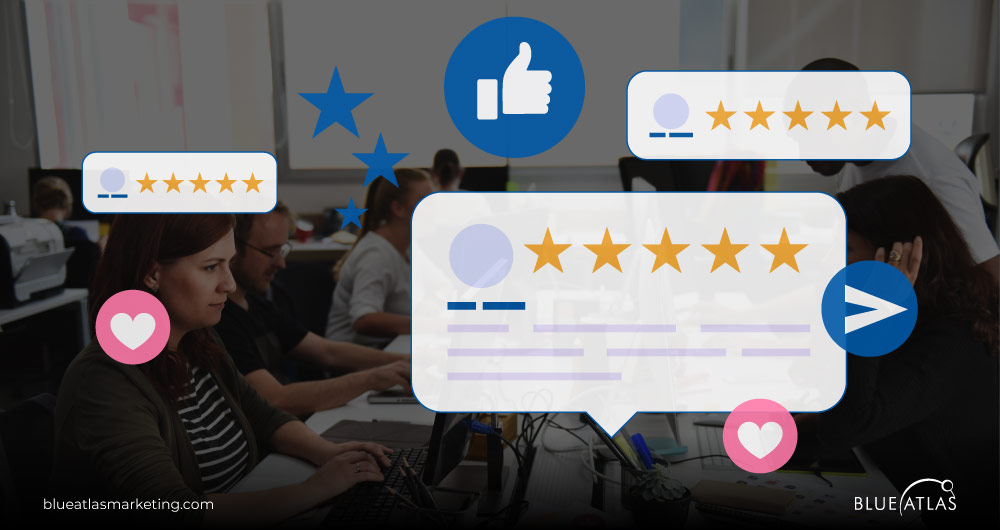
Choosing a WordPress maintenance provider is about finding a long-term partner who understands your website’s needs and supports your growth.
The right provider will align with your goals, offer reliable WordPress services, and provide measurable results.
When evaluating potential partners, assessing whether they have experience handling websites similar to yours is important.
If you run an e-commerce site, for example, your provider should be familiar with WooCommerce maintenance, payment security, and performance optimization.
A provider’s ability to customize solutions can make a significant difference. Whether you need a unique website design that aligns with your brand or a custom plugin to add specific functionality, a skilled maintenance partner should be able to handle both routine upkeep and tailored development.
Their expertise should cover standard WordPress management and extend to problem-solving, scalability, and long-term growth strategies.
Before committing, ask about their technical capabilities, past projects, and how they handle specialized requests. Also, review their pricing plan to ensure it fits your budget while providing the level of support your site requires.
Evaluating Reviews, Testimonials, and Service Level Agreements (SLAs)
Trusting a provider with your website requires proof of reliability.
Reviews and testimonials from past clients offer insights into a provider’s strengths, weaknesses, and responsiveness.
Look for feedback on their ability to resolve issues quickly, maintain uptime, and provide proactive communication.
Case studies or client success stories can also indicate whether they have experience working with businesses like yours.
Beyond reviews, Service Level Agreements (SLAs) are an essential part of assessing reliability.
An SLA outlines the provider’s commitment to response times, issue resolution, and support availability.
It helps set expectations for how quickly problems will be addressed and what level of service you can expect.
A strong SLA will include guaranteed response times—ideally within 24 to 48 hours—as well as escalation procedures for urgent issues.
It may be a red flag if a provider has vague SLAs or lacks client reviews.
A reliable maintenance partner should be transparent about their response times and service commitments, ensuring you have the support you need when it matters most.
Building Long-Term Partnerships for Website Growth
A good maintenance provider does more than just keep your site running—they help it grow.
A long-term partnership should go beyond basic updates and security to include strategies for improving user experience, content delivery, and customer engagement.
Maintaining a WordPress site isn’t just about fixing problems; it’s about understanding user behavior, optimizing content, and fostering customer loyalty.
A strong maintenance partner will analyze how visitors interact with your site and recommend improvements that enhance engagement.
This could involve refining website structure, improving page load speeds, or ensuring your content meets user needs.
Regular communication with your provider is key to long-term success.
A company that actively offers insights and suggests improvements rather than just reacting to issues will provide more value over time.
If your current provider only steps in when something goes wrong, it may be time to look for a partner that takes a proactive approach to website maintenance and growth.
Why Regular WordPress Maintenance Pays Off
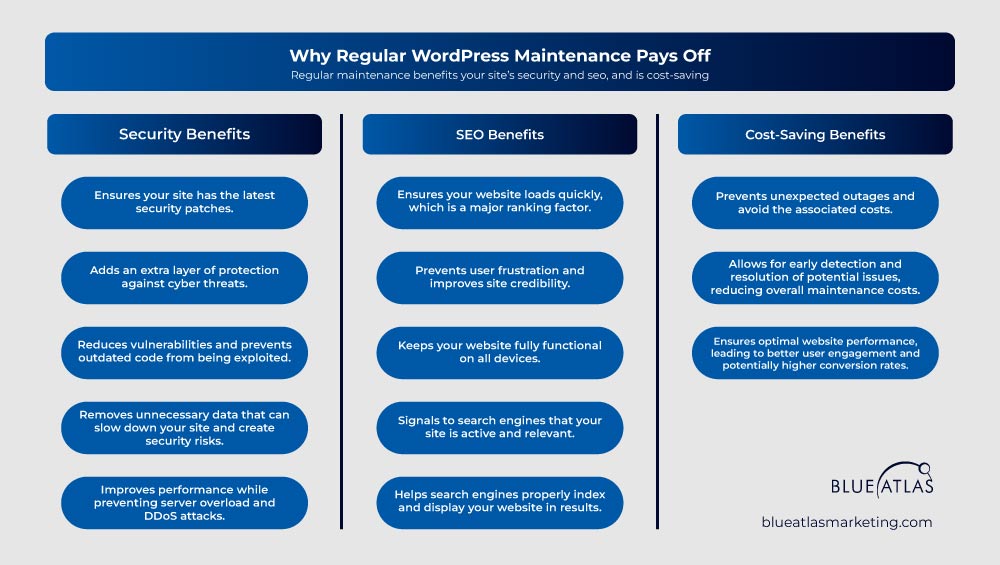
Skipping maintenance may not seem like a big deal—until your site crashes, rankings drop, or security threats emerge.
Regular maintenance helps prevent security breaches, malware attacks, and unexpected downtime.
Key security benefits include:
- Keeping WordPress core, plugins, and themes updated – ensures your site has the latest security patches.
- Using firewalls and malware scanners – adds an extra layer of protection against cyber threats.
- Removing unused plugins and themes – reduces vulnerabilities and prevents outdated code from being exploited.
- Optimizing the database – removes unnecessary data that can slow down your site and create security risks.
- Implementing a Content Delivery Network (CDN) and server caching – improves performance while preventing server overload and DDoS attacks.
Moving forward, well-maintained websites rank higher in search results and provide a better experience for visitors.
Key SEO benefits include:
- Optimizing images and reducing load times – ensures your website loads quickly, which is a major ranking factor.
- Fixing broken links and outdated content – prevents user frustration and improves site credibility.
- Ensuring mobile responsiveness – keeps your website fully functional on all devices.
- Posting fresh content regularly – signals to search engines that your site is active and relevant.
- Verifying your site with search engines – helps search engines properly index and display your website in results.
And lastly, implementing proactive website maintenance and monitoring offers significant cost-saving benefits:
- Reduced Downtime Costs – unplanned downtime can be financially draining. Proactive maintenance helps prevent unexpected outages, thereby avoiding associated costs.
- Lower Maintenance Expenses – regular upkeep allows for early detection and resolution of potential issues, reducing overall maintenance costs.
- Enhanced Performance and User Experience – consistent maintenance ensures optimal website performance, leading to better user engagement and potentially higher conversion rates.
Frequently Asked Questions (FAQs)
Why do I need a WordPress maintenance service?
Regular maintenance keeps your site secure, fast, and functional. Without it, you risk security breaches, slow performance, and downtime. A WordPress support service helps manage updates, backups, and security checks, ensuring your website stays protected and performs well for visitors.
What should I look for in a WordPress maintenance provider?
Choose a provider with experience, strong security measures, reliable technical support, and transparent pricing. A good choice includes regular monitoring, expert troubleshooting, and access to professionals who can prevent problems before they affect your website’s stability.
Is outsourcing WordPress maintenance cost-effective for small businesses?
Yes. It prevents expensive emergency fixes and ensures your site runs smoothly without requiring in-house expertise. Many providers offer different plans suited to various budgets, allowing small businesses to get professional assistance without the cost of hiring a full-time developer.
How often should my website be updated?
Core updates, plugins, and backups should be managed weekly or as needed. Using a staging site for testing before applying updates to your live site helps prevent errors and ensures that everything runs smoothly without disrupting user experience.
Does maintenance include SEO improvements?
Yes, a well-maintained site improves speed, security, and rankings. Regular malware removal, performance optimization, and database cleanup contribute to a faster and safer website, which enhances user experience and supports better search engine visibility.
Selecting the best WordPress maintenance services goes beyond just keeping your site online—it’s about security, performance, and long-term growth.
With regular plugin updates and proactive management, a well-maintained website enhances security, boosts search rankings, and prevents costly issues before they occur.
Choosing a provider with years of experience, a dedicated customer support team, and a trusted WordPress expert ensures you receive reliable service tailored to your needs.
Why Blue Atlas Marketing?
We provide top-tier WordPress website maintenance services tailored to your business needs.
Our expert team handles everything from security monitoring to performance optimization, ensuring your site remains fast, secure, and reliable.
Whether you run a blog, an eCommerce store, or a business website, we keep your landing pages and content performing at their best.
With a strong foundation in web design and WordPress maintenance, we take care of the details so you can focus on growing your business. Contact us today and let us handle the maintenance of your website!

